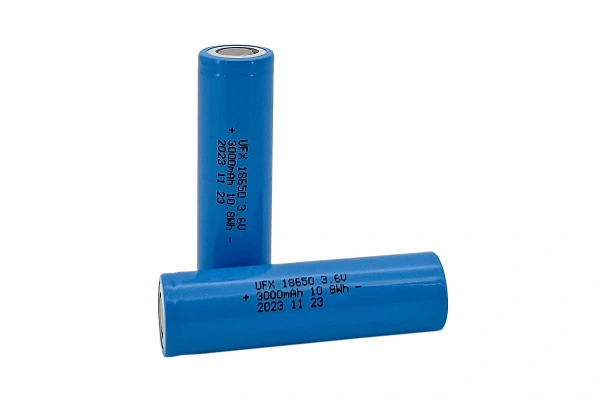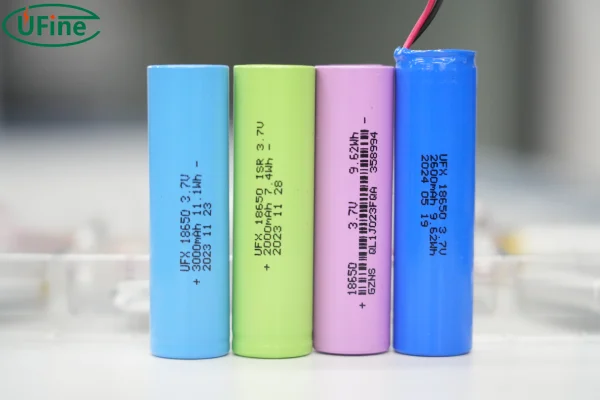This article is a complete overview of the 18650 battery. We will discuss what is an 18650 battery, its type, life, voltage, price, highest capacity, and applications.
Part 1. What is an 18650 battery?
18650 is just the size model of the battery, which refers to the external size of the battery.
- 18 means the battery diameter is 18 mm;
- 65 means the battery height is 65 mm;
- 0 represents a cylindrical battery.
So, the 18650 battery is a cylindrical battery with a diameter of 18 mm and a height of 65 mm.
18650 battery parameters
- 18650 cell voltage: 3.6V or 3.7V;
- Charging voltage: 4.20V (lithium cobalt oxide battery is 4.2V-4.3V);
- Minimum discharge termination voltage: 2.75V;
- Maximum charge termination voltage: 4.20V;
- Diameter: 18±0.2mm;
- Height: 65±2.0mm;
- 18650 battery capacity: more than 1000mAh. Some battery brands will mark amazing capacities, such as 3600mAh or 4500mAh.
Part 2. 18650 battery type
18650 battery types can be divided into 18650 lithium-ion batteries, 18650 LifePO4 batteries, and 18650 nickel-metal hydride batteries according to the cathode material. The most common of these is the lithium-ion 18650 battery.
- 18650 lithium-ion battery: The voltage of 18650 lithium-ion battery is 3.7V or 4.2V. Most 18650 lithium-ion batteries have a capacity of 1500mah-3100mah.
- 18650 LifePO4 battery: The voltage of 18650 LifePO4 battery is 3.2V or 3.65V.
- 18650 Ni-MH battery: The voltage of the Ni-MH 18650 battery is 1.2V. The capacity of the NiMH battery is 2100mAh. Most NiMH 18650 batteries have a capacity of 2500mah.
Part 3. What is the 18650 battery voltage?
As mentioned before, the 18650 battery voltage is usually 3.6V to 3.7V. The voltage can reach 4.2V when charging. The voltage during discharge can reach 2.5V.
However, some people found that the voltage of some 18650 batteries is marked 3.7V, and some are marked 4.2V. It’s all the same. But this is just a different labeling by the battery manufacturer.
3.7V refers to the platform voltage (i.e., average voltage) of the 18650 battery when it is used. And 4.2v refers to the voltage when the 18650 battery is fully charged.
Part 4. What is the Highest capacity 18650?
Generally speaking, the capacity of the 18650 battery can range from 1200mAh to 3600mAh. The larger the capacity, the longer the battery life. And many battery capacities are only about 800mAh. Currently, the highest capacity 18650 is 3600mAh. However, its capacity will be higher if it is an 18650 lithium battery pack.
However, for experienced customized lithium battery manufacturers like Ufine Battery, the 18650 battery capacity can range from 100mAh to 3500mAh.
Part 5. How long is the 18650 battery life?
18650 battery life has a long life. The cycle life can reach more than 500 times under normal use. Most 18650 battery life is about 500 to 1000 times, more than twice that of ordinary batteries.
Of course, 18650 battery life is also related to the battery manufacturing process, usage methods, usage environment, etc.
Factors affecting 18650 battery life
1. Discharge depth and rechargeable times
The number of times the 18650 battery can be charged is related to the depth of discharge. The deeper the battery is discharged, the fewer times it can be recharged.
Number of rechargeable times * depth of discharge = total number of completed charging cycles.
The higher the number of total charging cycles completed, the longer the battery life is. That is the number of rechargeable times * depth of discharge = actual battery life.
2. Overcharge, over-discharge, and large charging and discharging currents
Any overcharging can cause the 18650 battery life to be severely damaged or even explode. Therefore, overcharging the 18650 battery should be avoided.
At the same time, avoid deep discharge below 2V or 2.5V. Failure to do so will quickly and permanently damage the lithium-ion battery, and internal metal plating may occur, causing a short circuit.
Also, avoid large charging and discharging currents. Because the large current puts excessive stress on the battery.
3. Overheating or overcooling environment
The temperature has a greater impact on the 18650 battery life. The sub-zero environment will likely cause the 18650 battery to be burned when the electronic product is turned on. On the other hand, an overheated environment will reduce the capacity of the 18650 battery.
- 18650 lithium-ion battery charging temperature range: 0-45℃;
- 18650 lithium-ion battery discharge temperature range: 0-60℃;
4. Full power or no power for a long time
Too high or too low battery status is not conducive to maintaining the life of the 18650 battery. When the 18650 lithium battery is in a state of no power or low power for a long time, the resistance to the movement of electrons inside the lithium battery will increase, reducing battery capacity.
It is best for 18650 lithium batteries to be in the middle of charge. That is to maintain 50% power. In this case, the 18650 battery life is the longest. Generally speaking, maintaining 10%-90% of the power protects the battery.
Part 6. 18650 battery recommendation
Here we list several high-capacity 18650 battery manufacturers, models, battery capacity, battery voltage and battery weight.
| Battery manufacturer | Model | Capacity (mAh) | Nominal Voltage (V) | Weight (g) |
|---|---|---|---|---|
| Ufine Battery | UFX0656-13 | 3500 | 3.7 | 44 |
| Panasonic | NCR 18650GA | 3450 | 3.6 | 48 |
| Samsung SDI | INR18650-35E | 3450 | 3.6 | 50 |
| LG Chem | INR18650MJI | 3500 | 3.6 | 48 |
| NanoGraf | 18650-2021 | 3800 | N/A | N/A |
| Ufine Battery | UFX0707-14 | 3000 | 3.6 | 44 |
Part 7. 18650 battery price
Different manufacturers, capacities, materials, whether there is a protective board, shell, brand, and other factors will affect the 18650 battery price. The following are the main four influencing factors:
- Battery Capacity: The 18650 battery price is directly proportional to the battery capacity. The larger the capacity, the greater the energy ratio, and the more raw materials are used, the higher the price.
- Battery Material: The structure of the raw material, so from the perspective of the positive electrode, the prices of lithium cobalt oxide, lithium manganate, ternary materials, and lithium iron phosphate will be different.
- Battery Brand: Besides, even for 18650 batteries with the same capacity, different brands will affect the 18650 battery price.
- Battery Shell: Lithium battery shell design can be divided into PVC heat sealing, plastic, and metal PVC heat sealing. The specific shell packaging form used outside the 18650 battery battery pack mainly depends on the specific product needs of the customer. These will affect the 18650 battery price.
Part 8. 18650 battery application
- Power tools: 18650 battery cells are commonly used in power tools, such as electric screwdrivers, electric drills, etc., to provide high power output;
- Electric vehicles: Some electric bicycles, electric motorcycles, etc., use 18650 batteries as a power source;
- Solar energy storage system: 18650 batteries can be used in solar energy storage systems to store solar energy to supply electricity;
- Drones: Some small and medium-sized drones use 18650 batteries as a power source;
- Household electronic equipment: Some household electronic equipment, such as portable speakers, wireless microphones, etc., use 18650 batteries as power sources;
- Electronic cigarettes: 18650 batteries are commonly used in electronic cigarette equipment to provide power support;
- Flashlight: Because 18650 batteries have larger capacity and higher voltage, they are often used in lighting equipment such as flashlights;
- Laptop batteries: Some laptops use 18650 batteries as part of the battery pack.
This article comprehensively introduces what is a18650 battery, its types, recommendations, lifespan, price, 18650 voltage, highest capacity 18650, and factors affecting 18650 battery capacity. It will give you a more comprehensive understanding of 18650 batteries.
Related Tags:
More Articles

LiPo Battery Discharge Rate Guide & Calculation Tips
Understand LiPo battery discharge rates, C-ratings, and how to calculate max current. Essential guide for RC, drones, and electronics users.
High‑Capacity 3S LiPo Batteries: 5000 mAh vs. 10000 mAh
Compare 3S LiPo 5000mAh vs 10000mAh batteries by weight, power, and use. Find the best fit for your drone, RC car, or boat setup.
Top 5 Applications for Small 3S LiPo Batteries
Small 3S LiPo batteries power drones, RC gear, wearables, and robotics with high energy and low weight. Making them ideal for compact electronics projects.
Building and Charging Your Own 3S LiPo Pack: A Step‑by‑Step Guide
Learn how to build, balance, and charge a 3S LiPo battery pack safely at home with this complete DIY guide for hobbyists and beginners.
How to Choose the Right LiPo Battery Plug Type?
Discover the best LiPo battery plug types, how to choose them, and expert tips for safe usage, soldering, and maintenance.






